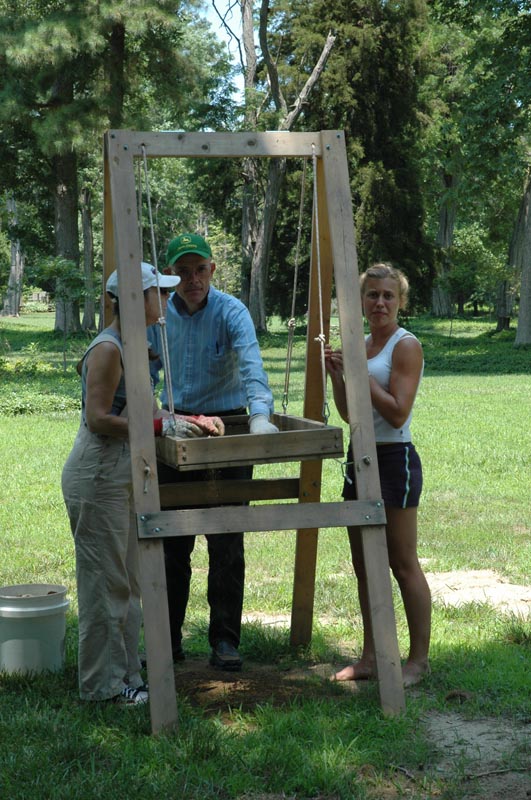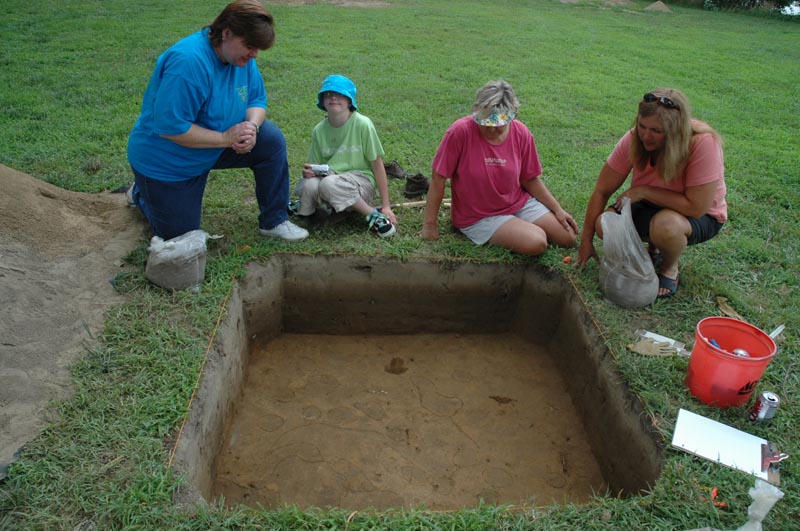 |
 |
|
Dr. Martin Gallivan and Gloucester teachers
participating in the 2004 teacher field school.
|

The following webpage was created for teachers
who would like to incorporate research at Werowocomoco into their
lesson plans. The page is broken up into two sections: a review
of the annual Gloucester teacher field school and list of the SOLs
related to Virginia Indians and their history. Each year there is
a field school for Gloucester teachers who help the students and
the research group excavate while recieving an introduction to archaeology
and learning about Virginia Indian history and culture. The following
summarizes field school students and teachersimpressions.
Teacher Field School
at Werowocomoco, 2004
In 2004, the Werowocomoco Research Group (WRG)
worked with Gloucester County school teachers as part of a cooperative
educational experience sponsored by the Virginia Foundation for
the Humanities (VFH). During the summer's archaeological field school
five teachers from Petsworth elementary school worked with the WRG
and students from the College of William and Mary learning archaeological
field techniques and developing lesson plans based on their experiences
at Werowocomoco.
 |
 |
|
Teacher field school participants work with
Sara Tolbert screening a test unit near the riverfront.
|
Theresa Owen, a senior Anthropology major at
William and Mary, was amazed at how much history was just beneath
the surface. But what was more interesting to her, though, was "how
archaeologists could piece together information about the history
and culture of the Virginia Indians from more than 400 years ago."
Eddie Dunlap, also a senior Anthropology major at William and Mary,
added that the excavation greatly changed his perception of archaeology.
He hopes that the work at Werowocomoco changes peoples' perceptions
of archaeology and what it can tell us about the past. "It
is not simply the artifacts which archaeologists search for,"
Dunlap explains, "but the context and association with their
location that tells the real story of the site."
Leonard "Preston" Higgins, an elementary
school teacher with over thirty-one years of experience, was amazed
at what he could learn from just a week working at Werowocomoco.
"I hope to transfer my enthusiasm for history and its importance
to my very impressionable 4th and 5th graders." For Rhonda
Lowe Taylor, the experience of working at Werowocomoco and learning
from the archaeologists and students "breathed life" into
the Virginia studies she teaches her students. Fellow teacher Roberta
Shifflett adds "I think it is important to better understand
the lives of Virginia Indians in the past so we can better teach
our students who these people were and how they influenced all of
our history."
 |
 |
|
Teacher field school participants work with
Lynn Ripley on a test unit near the riverfront.
|

Listed below are the pertinent sections of the Virginia SOLs related
to Virginia Indian history. These sections are verbatum from the
state guidelines.
K.1 Pocahontas:
She was an Indian girl (First American) who was a helper and friend
to the settlers in Jamestown.
2.2 Students will compare the lives (lifeways)
and contributions of American Indians with emphasis on the Powhatans
of the Eastern
Woodlands and other regions of the US.
2.4 Geography-locating the region of the Powhatan
Indians on maps.
The Powhatans farmed, fished, hunted, used trees for homes
and canoes, and gathered plants for food.
2.5 Locate the James River on maps.
VS.2d Artifacts such as arrowheads, pottery, and other tools that
have been found tell a lot about the people who lived in Virginia.
Powhatans were Algonquian speakers.
VS.2e Virginia's
Indians are referred to as Eastern Woodland Indians.
Adaptation
to the environment: The kinds of food they ate, the clothing
they wore and the shelters they had depended upon the seasons.
Foods changed with the seasons. In winter, they hunted birds
and animals.
In spring they fished and picked berries. In summer they grew
crops (beans, corn squash). In fall they harvested crops.
Animal skins (deerskin) were used for clothing.
Shelter was made from materials around them.
VS.3a Students will demonstrate knowledge of the first permanent
English settlement in America by explaining the reasons for English
colonization.
VS.3g The student will demonstrate knowledge of the first permanent
English settlement in America by describing the interactions between
the English settlers and the Powhatan people, including the contributions
of the Powhatans to the survival of the settlers.
- Captain John Smith initiated trading relationships with the Powhatans.
- The Powhatans traded food, furs and leather with the English in
exchange for tools, pots, guns, and other goods.
The Powhatan people contributed to the survival of the Jamestown
settlers in several ways:
- Pocahontas, daughter of Chief Powhatan, believed the English
and American Indians (First Americans) could live in harmony.
- Pocahontas began a friendship with the colonists that helped them
survive.
- The Powhatans introduced new crops to the English, including
corn and tobacco.
- The Powhatan people realized the English settlement
would continue to grow.
- The Powhatans saw the colonists as invaders
that would take over their land.
VS.4b The student wil demonstrate knowledge of the life in the Virginia
colony by describing how European immigrants, Africans and American
Indians influenced the cultural landscape and changed the relationship
between the Virginia colony and England.
Place names reflect culture.
US1.3a The student will demonstrate knowledge of how early cultures
developed in North America by locating where the American Indians
settled (emphasis on several areas including Eastern Woodland-Iroquois).
US1.3b The student will demonstrate knowledge of how early cultures
developed in North America by describing how the American Indians
used their environment to obtain food, clothing and shelter.
US1.4b The student will demonstrate knowledge of European exploration
in North America and West Africa by describing cultural interactions
between European and American Indians that led to cooperation and
conflict.
US1.5a The student will demonstrate knowledge of the factors that
shaped colonial America by describing the religious and economic
events and conditions that led to the colonization of America. |



